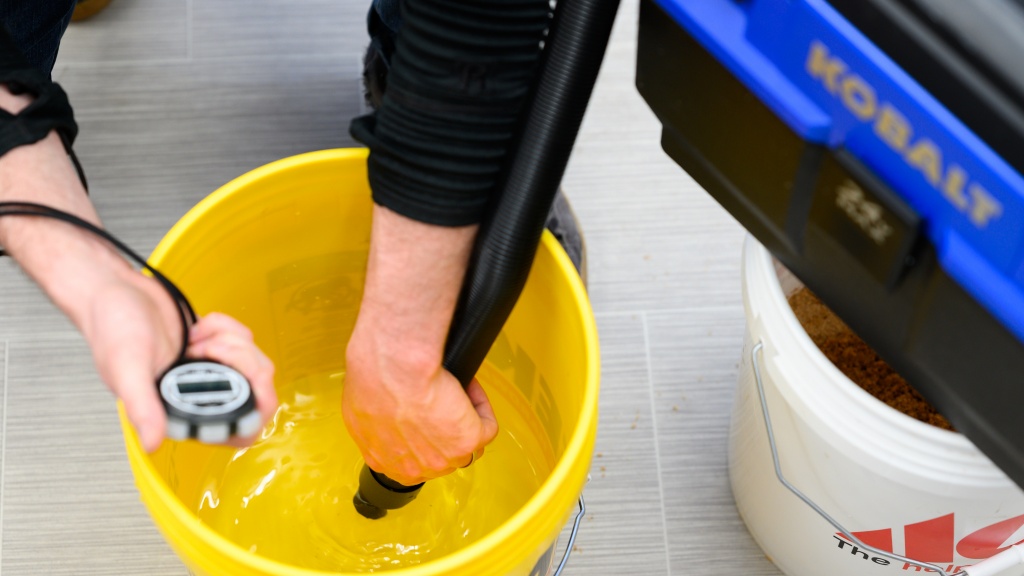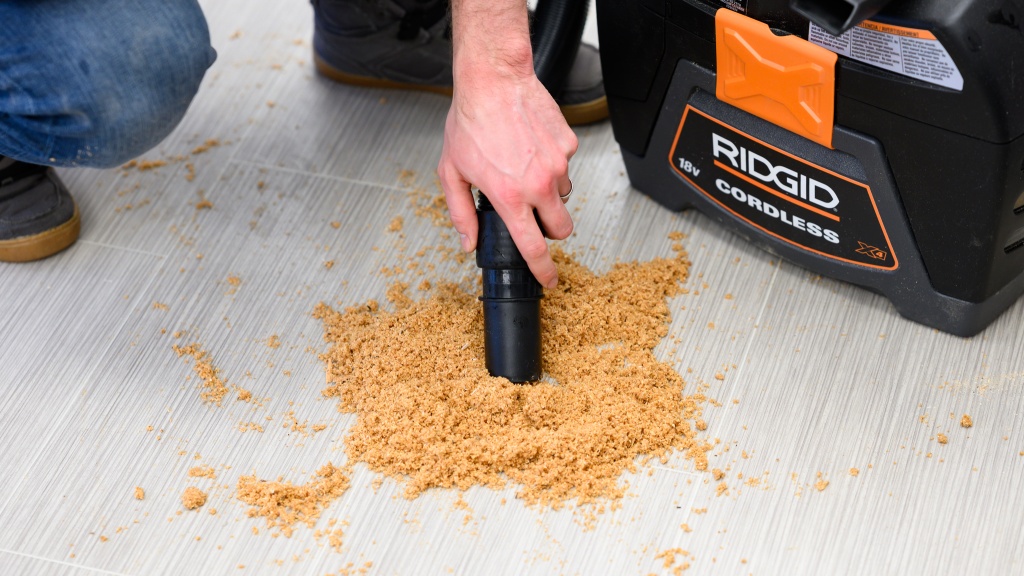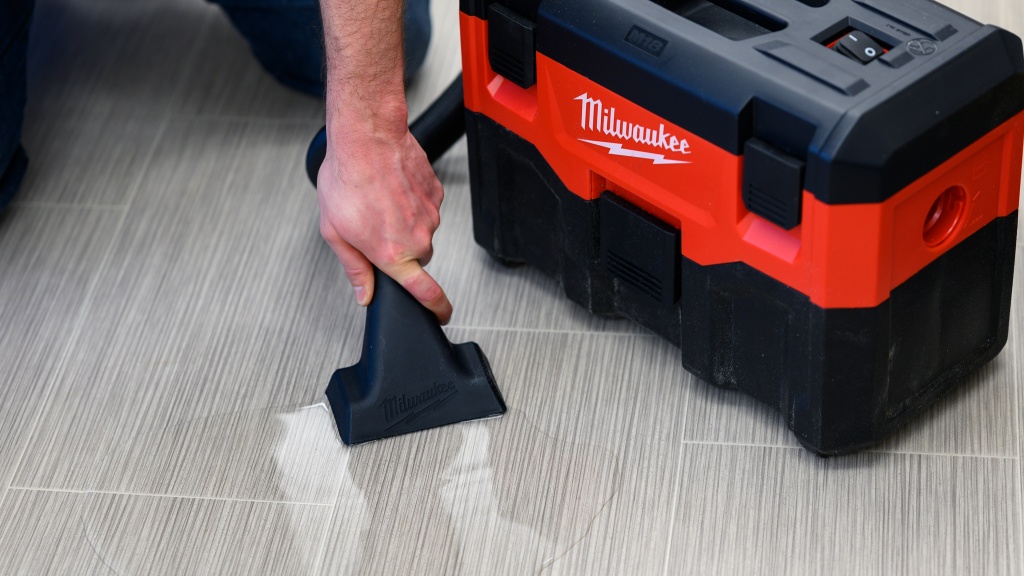To inform our review of cordless wet dry vacuums, we established broad categories covering the various applications for these machines. Within these categories, we nested practical tests that provide a granular look at specific vacuum uses. We call these broad categories metrics, and we weighted each according to their impact on the overall functionality of the products. The metrics and their weights are as follows: dry work (40%), wet work (30%), battery life (20%), and convenience functions (10%). Below is a detailed description of the tests that comprise each metric.
Dry Work
Sucking up dry materials is a shop vacuum's primary function. To test these machines' capabilities in this application, we broke up our analysis into the sub-metrics of heavy debris, large sawdust pile, and crevices. All of these tests evaluate suction power and, to a lesser degree, the internal features of the hose. No attachments were used in the heavy debris and sawdust tests. However, the "crevice" or "multipurpose" attachment was used in the crevice test.
The heavy debris test assesses each vac's ability to suck up large, weighty objects such as 2" washers, 1 1/2" machine bolts and the matching nuts, 1" carriage bolts, 1" lag screws and 1" wood screws. Additionally, we used a cylindrical 100-gram weight that is 1" in diameter. The goal is to suck these items up into the canister without clogging the tube. The machines were rated as passed, struggled to pass or failed to pass the object.
In contrast to the heavy debris test, the less demanding sawdust sub-metric is a time-based assessment. The object of this evaluation is for the machine to remove 9 cups of dry sawdust from a pile on a hard surface as quickly as possible. As with the heavy debris test, no attachment was used on the hose.
Last but certainly not least is the "crevice test." This analysis makes use of the vac's aptly named crevice tool to access and clean narrow, hard-to-reach places. In this analysis, we used rice as the debris to be collected. We constructed a narrow plexiglass slot so that we could see and measure the work being done. Using this setup, we measured the maximum depth the attachment could penetrate the slot and the maximum distance from the debris that the machines could extract said debris within the slot.
Wet Work
We performed extensive wet testing with the vacuums. This demanding evaluation consists of water lifting and suction, wet sawdust, and puddle clean-up, as well as sucking liquids out of a car's floorboard mats. Except for the water drawing test, the vacuum filter was in place throughout the evaluation.
The water lifting test is a practical assessment of a vacuum's ability to rapidly move a liquid. The test is a timed evaluation that requires the vacuum to convey 2 gallons of water from ground level to a height of 14.5" (the height of the 5-gallon bucket the vacuum was sitting on), plus the height of the tube port on the body of the machine. This task requires the machine to pull 16.68 pounds of water through the hose and into the canister. No attachments were used during this test.
In contrast to the timed water-lifting test, the water suction test is a measure of the suction produced by the vacuum. This is a standardized measurement and is expressed in cubic inches of water that can be drawn up in a continuous vertical column. We ran this test with a water lift gauge that attaches to the vacuum. The test was performed a half dozen times, and the average was used for ranking the machines.
As with the dry work metric, the wet work metric makes use of sawdust. However, in this case the sawdust is mixed with 6 cups of water before being piled on a hard surface. The vacuums are rated on how quickly they can clean-up the wet debris.
The vacs were also tested for their ability to clean up liquids on a hard surface, simulating a glass of water spilled on a kitchen floor. We call this the puddle test. For this analysis, we spread out 3 cups of water on a linoleum sheet and recorded the time it took to suck up the fluid. Additionally, we rated how thoroughly the fluid was cleaned from the floor.
As a final measure of the vacuums' ability to clean up liquids, we performed a saturated material test. In this assessment, we used a car floorboard mat and saturated it with 2 cups of water. The water was then removed by suction without the use of an attachment on the end of the hose. The water that was removed was then drained from the canister and measured. The greater the amount of water extracted, the higher the score.
Battery Life
Battery life is measured as the runtime of the unit when operating without a load. This means that the vacuums were only sucking air. During this test, a fully charged battery is used, as is a brand new filter. The vacuums were run continuously until their batteries were no longer capable of powering the motor, and they shut off. Scores are based on the length of time that the unit ran.
Convenience
The convenience metric takes stock of the physical dimensions (including the attachments) and the weight of each vacuum. We measure the hose length both in its natural state and fully stretched out. The hose is also assessed for its resistance to being crushed when stepped on by a 180 lbs person. We evaluate the filtering system, too. Is the filter a high-efficiency particulate air (HEPA) filter? Will it trap asbestos fibers and mold spores? Is the filter washable? Are replacement or upgrade filters available? Finally, we measured the noise level (dBa) at 3 ½ feet.
Conclusion
Jeez! Who knew so much went into a thorough assessment of cordless wet dry vacuums? Well, we did. And, now you do, too. Hopefully, this article has provided a full understanding of how we measure these machines' performance, why we have given awards to some models and not others, and some insight into which product is best for you.












